The pinewoods darter is a species of freshwater ray-finned fish, a darter from the subfamily Etheostomatinae, part of the family Percidae, which also contains the perches, ruffes and pikeperches. It is endemic to the eastern United States where it is only known to occur in the Little Peedee River system in the Carolinas. It inhabits creeks, preferring gravel riffles and vegetated areas with strong currents. This species can reach a length of 7.6 centimetres (3.0 in) TL though most only reach about 5.2 centimetres (2.0 in).
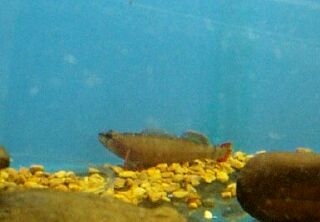
The yellowcheek darter is a species of freshwater ray-finned fish, a darter from the subfamily Etheostomatinae, part of the family Percidae, which also contains the perches, ruffes and pikeperches. It is endemic to the eastern United States where it is only known to occur in the state of Arkansas in the Little Red River. It inhabits medium-sized and smaller rivers in rocky riffles with strong current. This species can reach a length of 7.2 centimetres (2.8 in) TL though most only reach about 4.9 centimetres (1.9 in).
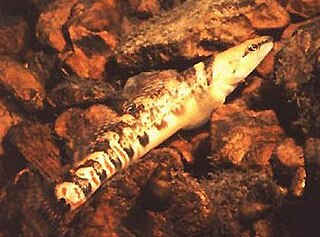
The Niangua darter is a species of freshwater ray-finned fish, a darter from the subfamily Etheostomatinae, part of the family Percidae, which also contains the perches, ruffes and pikeperches. It is endemic to Missouri, United States. It is found only in the Osage River Basin of central Missouri where its range historically included the Sac River, Pomme de Terre River, Niangua River, Big Tavern Creek, and Maries River. It is a federally listed threatened species of the United States.
Etheostoma pallididorsum, the paleback darter, is a species of freshwater ray-finned fish, a darter from the subfamily Etheostomatinae, part of the family Percidae, which also contains the perches, ruffes and pikeperches. It is endemic to Arkansas in the United States. It is only known to occur in the Caddo River and in Hallmans Creek, a tributary of the Ouachita River. This species inhabits headwaters and creeks where it lives in rocky, shallow pools and also in springs with plentiful vegetation growth. This species can reach a length of 6 centimetres (2.4 in) TL though most only reach about 3.9 centimetres (1.5 in).
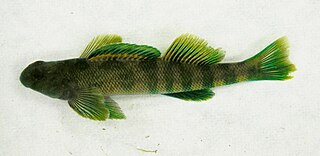
The greenside darter is a species of freshwater ray-finned fish, a darter from the subfamily Etheostomatinae, part of the family Percidae, which also contains the perches, ruffes and pikeperches. It inhabits swift riffles in the eastern United States and southern Ontario.
The cherry darter is a species of freshwater ray-finned fish, a darter from the subfamily Etheostomatinae, part of the family Percidae, which also contains the perches, ruffes and pikeperches. It is endemic to the upper Caney Fork system of the Cumberland River drainage in the U.S. state of Tennessee.
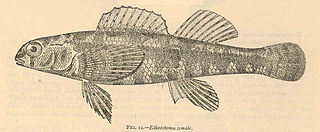
Etheostoma zonale, the banded darter, is a species of freshwater ray-finned fish, a darter from the subfamily Etheostomatinae, part of the family Percidae, which also contains the perches, ruffes and pikeperches. It is endemic to the eastern United States. It is mainly found in the Mississippi Basin, ranging from the Verdigris River in Kansas eastward to the Allegheny River in New York, and from the Minnesota River in Minnesota southward to the Ouachita River in Arkansas and the Tennessee River in Alabama. Its typical habitat in small and medium-sized rivers is riffles over cobble or gravel, rock slabs, and small boulders. It feeds on the riverbed on small insect larvae and is itself eaten by birds and larger fish. Males become more colorful and become territorial before spawning which takes place in spring. The females attach the eggs to waterweed. The population trend of this fish seems to be stable, it is a common species with numerous sub-populations over a wide range, no major threats have been identified and the International Union for Conservation of Nature has assessed its conservation status as being of "least concern".
The Cumberland darter is a rare species of freshwater ray-finned fish, a darter from the subfamily Etheostomatinae, part of the family Percidae, which also contains the perches, ruffes and pikeperches. It is endemic to Kentucky and Tennessee in the United States, where it occurs in the upper Cumberland River tributaries above Cumberland Falls. It was federally listed as an endangered species in the US on August 9, 2011.

Etheostoma etowahae, the Etowah darter, is a species of freshwater ray-finned fish, a darter from the subfamily Etheostomatinae, part of the family Percidae, which also contains the perches, ruffes and pikeperches. It is a rare species which is endemic to Georgia in the United States, where it occurs only in the Etowah River and two of its tributaries. It is a federally listed endangered species of the United States.
The stippled darter is a species of freshwater ray-finned fish, a darter from the subfamily Etheostomatinae, part of the family Percidae, which also contains the perches, ruffes and pikeperches. It is found in Missouri and White River drainages in Ozark Uplands of Missouri and Arkansas. Isolated population occurs in upper Castor River of southeastern Missouri. It inhabits rocky pools of headwaters and creeks. This species can reach a length of 10.0 cm (3.9 in).
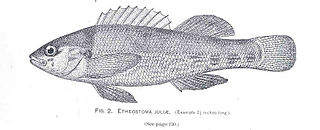
The yoke darter is a species of freshwater ray-finned fish, a darter from the subfamily Etheostomatinae, part of the family Percidae, which also contains the perches, ruffes and pikeperches. It is endemic to the eastern United States, where it occurs in the White River drainage in southern Missouri and northern Arkansas. It inhabits clear, fast, rocky riffles of creeks and small to medium rivers. This species can reach a length of 7.8 cm (3.1 in). The specific name honors Mrs Julia Hughes Gilbert, the wife of the American ichthyologist Charles Henry Gilbert (1859-1928).
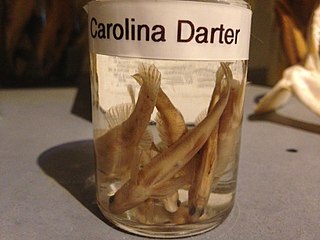
The Carolina darter is a species of freshwater ray-finned fish, a darter from the subfamily Etheostomatinae, part of the family Percidae, which also contains the perches, ruffes and pikeperches. It is endemic to the eastern United States, where it occurs in the Atlantic Piedmont from Roanoke River drainage of Virginia to Santee River drainage of South Carolina. It inhabits muddy and rocky pools and backwaters of sluggish headwaters and creeks. This species can reach a length of 6 cm (2.4 in). The Carolina darter was first formally described in 1935 as Hololepis collis by the American ichthyologists Carl Leavitt Hubbs (1894-1979) and Mott Dwight Cannon with the type locality given as a creek near York, South Carolina.
The backwater darter is a species of freshwater ray-finned fish, a darter from the subfamily Etheostomatinae, part of the family Percidae, which also contains the perches, ruffes and pikeperches. It is endemic to the eastern United States, where it occurs in coastal plain streams in the Mobile Bay drainage in Alabama and Mississippi. It occurs mud-bottomed, often vegetated, pools of sluggish creeks and small rivers. This species can reach a length of 4.4 cm (1.7 in).
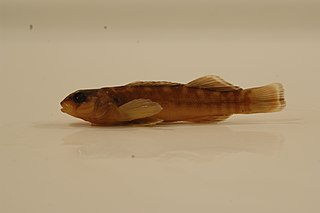
The orangebelly darter is a species of freshwater ray-finned fish, a darter from the subfamily Etheostomatinae, part of the family Percidae, which also contains the perches, ruffes and pikeperches. It is endemic to the eastern United States, where it occurs in the Ouachita and Red River drainages in southwestern Arkansas and southeastern Oklahoma. It occurs in gravel and rubble riffles and runs of creeks and small to medium rivers. This species can reach a length of 8.5 cm (3.3 in).
The strawberry darter is a species of freshwater ray-finned fish, a darter from the subfamily Etheostomatinae, part of the family Percidae, which also contains the perches, ruffes and pikeperches. It is endemic to the eastern United States, where it occurs in includes upland headwaters of the Strawberry River in Arkansas. It inhabits shallow gravel riffles, rocky runs, and pools of headwaters, creeks, and small rivers.
The current darter is a species of freshwater ray-finned fish, a darter from the subfamily Etheostomatinae, part of the family Percidae, which also contains the perches, ruffes and pikeperches. It is endemic to the eastern United States. This fish occurs in the Black River drainage system from south central Missouri to north central Arkansas, where it is found in shallow gravel riffles, sometimes rocky runs and pools of headwaters and creeks.

The Creole darter is a species of freshwater ray-finned fish, a darter from the subfamily Etheostomatinae, part of the family Percidae, which also contains the perches, ruffes and pikeperches. It is endemic to the Eastern United States, where it occurs in the Ouachita, Red, Calcasieu and Sabine River drainages in Arkansas and Louisiana. It inhabits gravel riffles, current-swept vegetation and debris in creeks and small to medium rivers. This species can reach a length of 7.4 cm (2.9 in). The creole darter was first formally described in 1969 by Ray S. Bridsong and Leslie William Knapp with the type locality given as the Dugdemona River, Jackson Parish, Louisiana.
The brook darter is a small species of freshwater ray-finned fish, a darter from the subfamily Etheostomatinae, part of the family Percidae, which also contains the perches, ruffes and pikeperches. It is endemic to the eastern United States, where it occurs in the upper Black River system in Missouri, from headwaters to where the River flows into the Mississippi River alluvial plain. It inhabits shallow gravel riffles, sometimes rocky runs and pools, of headwaters, creeks, and small rivers. The brook darter was first formally described in 1997 by Patrick A. Ceas and Lawrence M. Page with the type locality given as the Black River on the northeastern outskirts of Mill Spring, Missouri. The specific name honours Brooks M. Burr, Emeritus Professor and Curator of Fishes of Southern Illinois University who first brought the fish to the attention of the authors.
The Tennessee darter is a species of freshwater ray-finned fish, a darter from the subfamily Etheostomatinae, part of the family Percidae, which also contains the perches, ruffes and pikeperches. It is endemic to the eastern United States, where it occurs in the Tennessee River drainage from western Virginia to western Tennessee. It also occurs in the upper Bluestone River drainage in western Virginia. It inhabits current-swept rocky pools and adjacent riffles of creeks and small to medium rivers. This species can reach a length of 6 cm (2.4 in).
The Autumn darter is a species of freshwater ray-finned fish, a darter from the subfamily Etheostomatinae, part of the family Percidae, which also contains the perches, ruffes and pikeperches. It is endemic to the eastern United States, where it commonly occurs in the White River drainage and tributaries, and less so in the upper Current and Eleven Point Rivers, of Missouri and Arkansas, and the Little Red River in Arkansas.









